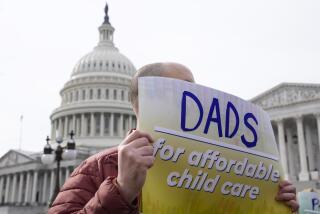Children’s Health Care Plan Urged : Reform: An advocacy group stresses the need to aid youngsters and pregnant women and calls for creation of $10-billion insurance program.
- Share via
WASHINGTON — In the divisive debate over health care reform, one consensus is emerging: the need to provide care for tens of millions of children and pregnant women who do not qualify for Medicare but cannot afford private insurance.
“There’s a broad consensus across the political spectrum--in both the private and public sectors--that you have to take care of these highly vulnerable populations,” said Richard I. Smith, policy director of the Washington Business Group on Health.
That realization was underscored again on Tuesday by the Children’s Defense Fund, a nonprofit advocacy group for children.
The group called for the creation of a $10-billion comprehensive health insurance program for children and pregnant women that it said could be paid for through higher alcohol and tobacco taxes.
“The private health insurance system is not working for 40% of all American children,” or about 25 million youngsters, said Marian Wright Edelman, president of the fund.
That opinion may be supported by increasing reports to the National Assn. of School Nurses that school infirmaries around the country are being besieged by uninsured children who often have serious problems that require medical treatment or even hospitalization.
One-third of the estimated 35 million Americans now without health insurance are children and, Edelman said, “millions more stand to lose private health insurance in the 1990s without fundamental and immediate reform in how America pays for the health care of children.”
Virtually every major reform plan pending in Congress would provide insurance for children and pregnant women. Those plans are based, at least in part, on the widely held belief that, over the long term, every dollar spent on prevention and immunization would save $3 in treatment.
Children also ranked high on the agenda last month when a high-level Bush Administration advisory group recommended to the White House a nationwide system of school-based health clinics. The President also is said to be considering a tax credit to help families purchase private insurance.
But Edelman said that such Bush Administration initiatives--like many congressional proposals--would be insufficient.
“Tax credits don’t treat strep throats. Tax credits don’t immunize babies, put eyeglasses on schoolchildren or provide cost-effective care for children who have treatable disabilities,” she said at a press conference here.
The Children’s Defense Fund, Edelman added, will actively support only plans that would both provide comprehensive health insurance for children and pregnant women and fund new public health programs, especially in “high need” communities.
According to Edelman, 72.8% of all children had medical coverage through employee plans in 1977. But 10 years later, that number was down to 62.9% and may sink to 50% by the end of the decade.
“The declines were seen among all types of employed families, including two-parent, two-wage earner families and single-parent working families,” she added.
Among the reasons for that decline are debt, parental separation, job change or layoff, according to Sara Rosenbaum, a health researcher at the Children’s Defense Fund.
Also on Tuesday, the Congressional Budget Office reported that all Americans could be covered by health insurance--and total health spending would drop by $26 billion--if the federal government’s Medicare payment scale were used to pay all doctors and hospitals.
“We can get more health care for fewer dollars,” said Rep. Pete Stark (D-Oakland), chairman of the health subcommittee of the House Ways and Means Committee, who requested the CBO study.
The current health care system has a widely varying system of payments. The cost of a particular medical procedure may differ simply depending on whether the patient is covered by private health insurance through the workplace, Medicare or Medicaid or is paying the bill out of his own pocket.
More to Read
Get the L.A. Times Politics newsletter
Deeply reported insights into legislation, politics and policy from Sacramento, Washington and beyond. In your inbox twice per week.
You may occasionally receive promotional content from the Los Angeles Times.










